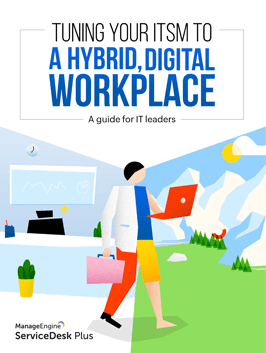In this first section of the change management guide, the focus is on the basics of change management; the key differences between incidents, problems, and changes; the benefits of comprehensive change management; and the overall process in an organization.
Introduction to IT change management

The business landscape and customer expectations are constantly changing, and digital transformation has become a key contributor to the success of businesses across industries. Digital transformation is all about leveraging available technology to address business challenges and seize opportunities. When you break it down, digital transformation is basically IT management done better to eliminate problematic areas and equip your IT infrastructure to face business challenges. And this involves implementing IT changes that help your organization apply new technology to existing business and IT processes.
These changes can be as simple as moving collaborative apps to the cloud for better operational efficiency, or taking a mobile-first approach for a better consumer experience. Despite their simplicity on the surface, these changes come with their own logistical challenges. Not implementing a change properly can cause your organization to take one step forward and two steps back.
A popular bank's failed mobile app upgrade back in December 2018 is a great example of how not to implement a change. The bank's plan to introduce a new and improved mobile banking app was a great idea and a much-needed one. But from the moment the new app was launched, it had problems. The bank introduced the new app after it had already phased out the old one. When the new app failed to work, thousands of customers were left unable to access their bank accounts through the app. To make matters worse, communication about a fix for the new app was minimal, leaving customers frustrated. The mobile app was down for four days before the bank decided to bring back the old app.
We can see that the bank failed at various stages of its proposed change: releasing the new app when it wasn't ready to be deployed, failing to be transparent and communicate downtime associated with the update to end users, and not coming up with an alternative plan in case of failure. Definitely not the way you'd want your change to be implemented.
This is where change management comes in; it helps you manage all the different changes in your organization and gives you a process for efficiently rolling out changes without affecting the rest of your organization. Change management reduces the chance of disruptions similar to what the bank faced.
In this guide, we'll cover the what, why, and how of change management. You'll learn how to help your organization keep up with industry trends with effective changes.
Let's get right into it!
What is change management?

IT change management is the process of tracking and managing a change throughout its entire life cycle, from start to closure, with the aim to minimize risk.
Setting up a systematic change management process helps your organization implement incident-free changes with a high success rate.
What is a change?
A change is "the addition, modification, or removal of anything that could have a direct or indirect effect on services."
At its simplest, any change to an organization's IT infrastructure that can affect the organization's operations is called an IT change. This includes replacing printers, projectors, servers, and more.
What's the difference between an incident, a problem, and a change?
| Incident | Problem | Change | |
|---|---|---|---|
| Definition | An incident is "an unplanned interruption to a service or reduction in the quality of a service." | A problem is "a cause, or potential cause, of one or more incidents." | A change is "the addition, modification, or removal of anything that could have a direct or indirect effect on services." |
| Scope | Restoring normal service operations as soon as possible | Identifying the root cause of disruptions to normal service operations | Implementing a change that addresses the root cause to prevent further disruptions to normal service operations |
| Nature | Reactive | Reactive and proactive | Reactive and proactive |
| Example | Users are unable to connect to the network. A workaround is issued to resolve the incident and give users access to the network. | A problem ticket is created to perform root cause analysis (RCA). A network switch is malfunctioning, leading to the incident. The switch needs to be replaced. | A change ticket is created to replace the defective switch. |
Why do organizations need change management?

Now that we know what change management is, let's look at why organizations need it, starting with the objectives of change management.
IT change management objectives
Give organizations the power to take control and manage their changes:
Change management will give you better control over your change process and help you implement changes with minimal risk. By following standard processes, change management ensures that all aspects of each change, such as planning, risk assessment, and tracking the implementation, are effectively managed. Utilizing a service desk tool to track changes from start to end can work wonders and enable an organization to better manage its IT infrastructure with well planned and executed changes.
Help organizations implement changes better:
By tracking the entire change process, change management makes it possible for organizations to stay on top of all change requests. It also makes it easier to identify and curb the number of unauthorized changes. By allowing users to submit a request for change (RFC) only through the service desk tool, organizations can collect all the necessary information about the change right at the beginning and then decide if the change needs to be implemented. A robust approval mechanism ensures that changes receive all the necessary permissions before they are implemented.
Enable continuous improvement:
Change management isn't just for a rainy day; it aims to help organizations continuously improve their infrastructure and processes, as well as keep up with industry trends by ensuring they can smoothly roll out the necessary changes without affecting current service operations.
Change management benefits
To the organization:
- Fewer change collisions thanks to effective management of changes.
- The ability to roll out upgrades without affecting operations.
- Fewer failed changes.
- Accurate classification of changes.
To end users:
- Better communication about downtime and unavailability of services due to scheduled changes.
- Smoother service operations with fewer disruptions caused by poorly planned changes.
How do organizations carry out change management?

Let's now look at how you can implement change management in your organization. The first thing is to set up an effective change process that enables you to plan changes, get the necessary approval, and implement changes. Here is a change management process you can follow to effectively handle changes.
The change management process

Step 1: Submission
The first stage is initiating the change. This involves collecting basic change ticket information like the change type and priority.
- Creation: Change tickets are initiated with the service desk tool. The necessary information is collected right at the beginning using a change form containing mandatory fields.
- Defining change roles: By using change roles, organizations can delegate change responsibilities to various stakeholders and control the level of access each role has for each stage of a change.
Step 2: Planning
The next stage is where the planning of the entire change happens. A well-planned change is the secret to a successful change implementation. It is also essential to get the necessary approvals required to implement the change. Details like the impact, rollout plans, backout plans, and associated downtime are documented to clearly convey the change plan to stakeholders and convince them that the change is worth doing.
Step 3: Approval
Next, the change plan needs to be approved by the change advisory board (CAB), emergency change advisory board (ECAB), and any other authority that has a stake in the change or in the organizational infrastructure affected by the change. Creating custom CABs helps organizations group relevant personnel to easily manage approvals. Automating the approval process speeds up the entire change and ensures that no approval requests are overlooked.
Note: The CAB is a combination of various job roles and teams. It may include C-level executives, team managers, technical teams, finance staff, and more, depending on the severity and scale of the change.
Step 4: Implementation
Once the necessary approvals are gained, the change can be implemented. Organizations can track and manage the implementation of changes by creating tasks or using a project.
- Delegation of work through tasks: Tasks are created and assigned to different technicians from different teams to easily manage the work done by all those involved in the implementation of the change. Parent and child tasks can be used to set up task dependencies and ensure that tasks are done in a particular order and that no tasks are missed.
- Leveraging project management: Organizations can use projects to handle large-scale changes, like moving the organization's entire infrastructure to the cloud. Projects support a larger scope of implementation and can better handle a greater number of tasks, people, and milestones. Strong integration between change management and project management can be very beneficial to organizations.
Step 5: Review
Next, a post-implementation review is carried out to ensure there are no deviations in the implementation and any issues are ironed out before the change is closed.
Step 6: Closure
This is the last step in the change management process. The nature of the completed change is recorded as successful, failed, or incomplete. Recording the right closure code makes an organization's metrics much more accurate and useful.
Change management feature checklist

Here is a list of features that you need to keep an eye out for when choosing a service desk tool. Having these features in place will help you implement an effective change management process in your organization.
Change management
Change creation and logging
- Create changes from incidents and problems, and carry over the necessary information.
- Collect required information with custom change templates.
- Create different types of changes, and build unique workflows for each type.
- Involve the right stakeholders, like the change owner, approver, line manager, and change reviewer, using change roles.
Change planning and evaluation
- Create elaborate change plans featuring impact analysis and rollout, backout, and downtime plans.
- Maintain a checklist of essential steps to be completed.
Change approval
- Form multiple CABs.
- Configure multiple levels of approval. Mark whether the RFC has to be approved by all members of the CAB or by any one member.
- Allow the change manager to have final say over the approval of the change.
- Bypass approvals from the change manager and change approver by auto-approving the change when all CAB members recommend it.
- Mark end users as service request approvers.
Coordinating change implementation
- Break down changes into tasks, and use work logs to estimate how long it will take the change implementation team to complete activities.
- Streamline implementation by creating projects from a change or associating a change with existing projects.
- Track all associated incidents and problems that caused or were caused by the change.
- Schedule downtime and announce it to key stakeholders.
- Keep stakeholders in the loop with regular notifications.
Change review and closure
- Document post-implementation review (PIR).
Change workflows
- Create distinct workflows for different change types and processes with varying levels of complexity and functions.
- Configure various actions like conditions, switches, notifications, field updates, and approvals during the transition between stages.
- Draw up change workflows on a drag-and-drop canvas.
Tick all the boxes for effective change management
FAQs

IT change management is the process of tracking and managing a change throughout its entire life cycle, from start to closure, with the aim to minimize risk. Setting up a systematic change management process helps your organization implement incident-free changes with a high success rate.
Changes can be broadly divided into three types: standard, normal, and emergency changes.
These are preapproved changes that are low-impact, well-known, and documented.
Example: Replacing a printer's ink cartridge
A normal change needs to follow the entire change process; it should be scheduled, have its risk assessed, and be authorized. Normal changes include both minor (low to medium impact and urgency) and major changes (high impact and urgency).
Example: Moving on-premises services to the cloud
Emergency changes have high impact and urgency, requiring expedited assessment, approval, and implementation to get services up and running as soon as possible.
Examples: Primary server failure, data center disruption, emergency patch for security vulnerability
IT change management is important because it,
- 1. Gives organizations the power to take control and manage their changes
- 2. Helps organizations implement changes better; and
- 3. Enables continuous improvement
Here are the benefits of IT change management:
To the organization:- Fewer change collisions thanks to effective management of changes.
- The ability to roll out upgrades without affecting operations.
- Fewer failed changes.
- Accurate classification of changes.
- Better communication about downtime and unavailability of services due to scheduled changes.
- Smoother service operations with fewer disruptions caused by poorly planned changes.







